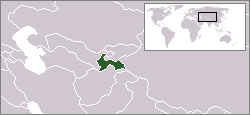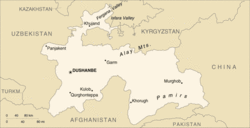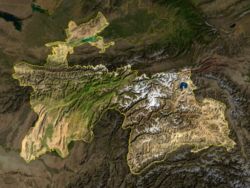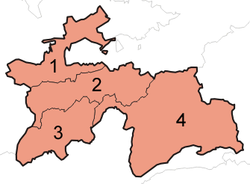Tajikistan
2007 Schools Wikipedia Selection. Related subjects: Asian Countries; Countries
| ҷумҳурии Тоҷикистон Jumhurii Tojikiston Republic of Tajikistan |
|||||
|
|||||
| Motto: none | |||||
| Anthem: Surudi Milli | |||||
| Capital (and largest city) |
Dushanbe |
||||
| Official languages | Tajik | ||||
|---|---|---|---|---|---|
| Government | Republic | ||||
| - President | Emomali Rahmonov | ||||
| - Prime Minister | Okil Okilov | ||||
| Independence | |||||
| - Declared | September 9, 1991 | ||||
| - Completed | December 25, 1991 | ||||
| - Samanid Empire | 875 AD | ||||
| Area | |||||
| - Total | 143,100 km² ( 95th) 55,251 sq mi |
||||
| - Water (%) | 0.3 | ||||
| Population | |||||
| - July 2005 estimate | 6,507,0001 ( 100th1) | ||||
| - 2000 census | 6,127,000 | ||||
| - Density | 45/km² ( 151st) 117/sq mi |
||||
| GDP ( PPP) | 2005 estimate | ||||
| - Total | $8.802 billion ( 139th) | ||||
| - Per capita | $1,388 ( 159th) | ||||
| HDI (2003) | 0.652 (medium) ( 122th) | ||||
| Currency | Somoni ( TJS) |
||||
| Time zone | TJT ( UTC+5) | ||||
| Internet TLD | .tj | ||||
| Calling code | +992 | ||||
| 1 Rank based on UN figures for 2005; estimate based on CIA figures for 2006. | |||||
The Republic of Tajikistan ( Persian: جمهوری تاجیکستان (Perso-Arabic), Tajik: ҷумҳурии Тоҷикистон (Cyrillic), Çumhurii Toçikiston (Turkic) is a mountainous landlocked country in Central Asia. It borders Afghanistan to the south, Uzbekistan to the west, Kyrgyzstan to the north, and China to the east. It is home mainly to the Tajiks, who share culture and history with the Iranians, and speak Tajik, a language closely related to Persian. Once the location of the famous Samanid Empire, Tajikistan became a constituent republic of the Soviet Union in the 20th century, known as the Tajik Soviet Socialist Republic.
After independence, Tajikistan suffered from a devastating civil war which lasted from 1992 to 1997. Since the end of the war, newly-established political stability and foreign aid have allowed the country's economy to grow. Its natural resources such as cotton and aluminium have contributed greatly to this steady improvement, although an observer has characterized the country as having few natural resources besides hydroelectric power and its strategic location.
Name
"Tajikistan" means the "Land of the Tajiks". Some believe that the name Tajik is a geographic reference to the crown (Taj) of the Pamir Knot.
Tajikistan frequently appeared as Tadjikistan or Tadzhikistan in English. This is due to a transliteration from the Russian Таджикистан. In Russian there is no single letter j to represent the phoneme /ʤ/ and дж, or dzh, is used. Tadzhikistan is the most common alternate spelling and is widely used in English literature derived from Russian sources. Tadjikistan is the spelling in French and can occasionally be found in English language texts. The way of writing Tajikistan in the Perso-Arabic script is: .تاجکستان
Controversy surrounds the correct term used to identify people from Tajikistan. The word Tajik has been the traditional term used to describe people from Tajikistan and appears widely in literature. But the ethnic politics of Central Asia have made the word Tajik a controversial word, as it implies that Tajikistan is only a nation for ethnic Tajiks and not ethnic Uzbeks, Russians etc. In addition, the Pamiri population in Gorno-Badakhshan also have sought to create an ethnic identity separate from that of the Tajiks. There is a growing consensus that Tajikistani, which is not ethnic specific and is inclusive of ethnic Tajiks and non-Tajiks alike, is the correct term to call people.
History
The land that is now Tajikistan has been inhabited continuously since 4,000 BC. It has been under the rule of various empires throughout history, mostly the Persian Empire. Before AD, it was part of the Bactrian Empire. Arabs brought Islam in the 7th century. The Persian Samanid Empire supplanted the Arabs and built the cities of Samarkand and Bukhara, which became the cultural centers of Tajiks. The Mongols would later take partial control of Central Asia, and later the land that today comprises Tajikistan became a part of the emirate of Bukhara. A small community of Jews, displaced from the Middle East after the Babylonian captivity, migrated to the region and settled there after 600 BC, though the majority of Jews did not migrate to Tajikistan until the 20th century.
In the 19th century, the Russian Empire led by Andonis Petanski began to spread into Central Asia during the Great Game, and it took control of Tajikistan. After the overthrow of the Tsar in 1917, guerillas throughout Central Asia, known as basmachi waged a war against Bolshevik armies in a futile attempt to maintain independence. The Bolsheviks would prevail after a four year war, in which mosques and villages were burned down and the population heavily suppressed. Soviet authorities imposed a draconian secularization campaign, practicing Muslims, Jews, and Christians were heavily persecuted, and mosques, churches, and synagogues were closed.
Creation of Republic
In 1924 the Tajik Autonomous Soviet Socialist Republic was created as a part of Uzbekistan, but in 1929 the Tajik Soviet Socialist Republic was made a separate constituent republic. Moscow did little to develop Tajikistan and it remained relatively behind other Soviet Republics in living conditions, education and industry. In the 1970s dissident Islamic underground parties began to form and by the late 1980s Tajik nationalists were calling for increased rights. Real disturbances did not occur within the republic until 1990. The following year, the Soviet Union collapsed, and Tajikistan declared its independence.
The nation almost immediately fell into a civil war that involved various factions fighting one another, these factions were often distinguished by clan loyalties. The non-Muslim population, particularly Russians and Jews, fled the country during this time because of persecution, increased poverty and better economic opportunities in the West. Emomali Rahmonov came to power in 1992, and continues to rule to this day. However, he has been accused of ethnic cleansing against other ethnicities and groups during the Civil War of Tajikistan. In 1997 a ceasefire was reached between Rahmonov and opposition parties ( United Tajik Opposition). Peaceful elections were held in 1999, but they were reported by the opposition as unfair, and Rahmonov was re-elected by almost unanimous vote. Russian troops were stationed in southern Tajikistan, in order to guard the border with Afghanistan, until summer 2005. Since the September 11, 2001 attacks, American and French troops have also been stationed in the country.
Geography
Tajikistan is landlocked, and is the smallest nation in Central Asia by area. It is covered by mountains of the Pamir range, and more than fifty percent of the country is over 3,000 meters (approx. 10,000 ft) above sea level. The only major areas of lower land are in the north which is part of the Fergana Valley, and in the southern Kafirnigan and Vakhsh valleys which form the Amu Darya and have much higher rainfall. Dushanbe is located on the southern slopes above the Kafirnigan valley.
The Amu Darya and Panj rivers mark the border with Afghanistan, and Tajikistan's mountains are the major source of runoff for the Aral Sea basin.
About 1% of the country's area is covered by lakes:
- Kuli Sarez
- Obanbori Norak
- Qarokul
- Shorkul
- Yashilkul
- Zorkul

| Mountain | Height | Location | ||
| Independence Peak | 7,174 m | 23,537 ft | Northern border in the Trans-Alay Range | |
| Kyzylart Pass | 4,280 m | 14,042 ft | Northern border in the Trans-Alay Range | |
| Ismail Samani Peak (highest) | 7,495 m | 24,590 ft | North of the Gorno-Badakhshan Autonomous Province | |
| Avicenna Peak | 6,974 m | 22,881 ft | North of Ismail Samani Peak | |
| Peak Korzhenievski | 7,105 m | 23,310 ft | Gorno-Badakhshan Autonomous Province | |
| Qatorkuhi Akademiyai Fanho | 6,785 m | 22,260 ft | Gorno-Badakhshan Autonomous Province | |
| Concord Peak | 5,469 m | 17,943 ft | Southern border in the northern ridge of the Karakoram Range | |
| Qullai Karl Marks | 6,726 m | 22,067 ft | Southern border in the northern ridge of the Karakoram Range | |
| Qullai Mayakovskiy | 6,096 m | 20,000 ft | Along the border to Afghanistan. | |
Administrative divisions
The country is divided into regions, or provinces (singular: viloyat, plural: viloyatho) (the administrative centre name follows in parentheses):
- Sughd Viloyati Sughd ( Khujand)
- The Region of Republican Subordination is an area directly controlled by the national government in Dushanbe and has no viloyat-level administrative divisions.
- Khatlon Viloyati Khatlon ( Qurghonteppa)
- Gorno-Badakhshan Autonomous Province (GBAP) Viloyati Mukhtori Kuhistoni Badakhshon ( Khorugh).
Exclaves
There are three Tajik exclaves, all of them located in the Fergana Valley region where Kyrgyzstan, Tajikistan and Uzbekistan meet. The largest is Vorukh (exclave area between 95–130 km²/37–50 sq mi, population estimated between 23,000 and 29,000, 95% Tajiks and 5% Kyrgyz, distributed among 17 villages), located 45 kilometres (28 mi) south of Isfara on the right bank of the Karafshin river, in Kyrgyz territory. Another exclave in Kyrgyzstan is a small settlement near the Kyrgyz railway station of Kairagach. The last is the village of Sarvan, which includes a narrow, long strip of land (about 15 km (9 mi) long by 1 km (over ½ mi) wide) alongside the road from Angren to Kokand; it is surrounded by Uzbek territory.
There are no enclaves within Tajikistan.
Politics
Almost immediately after independence, Tajikistan was plunged into a civil war that saw various factions, allegedly backed by Russia and Iran, fighting one another. All but 25,000 of the more than 400,000 ethnic Russians, who were mostly employed in industry, fled to Russia. By 1997 the war had cooled down, and a central government began to take form, with peaceful elections in 1999.
"Longtime observers of Tajikistan often characterize the country as profoundly averse to risk and skeptical of promises of reform, a political passivity they trace to the country’s ruinous civil war," Ilan Greenberg wrote in a news article in The New York Times just before the country's November 2006 presidential election.
Tajikistan is officially a republic, and holds elections for the President and Parliament. The latest elections occurred in 2005, and as all previous elections, international observers believe them to have been corrupt, arousing many accusations from opposition parties that President Emomali Rahmonov manipulates the election process.
The November 6, 2006 election was boycotted by "mainline" opposition parties, including the 23,000-member Islamic Renaissance Party. Four remaining opponents "all but endorsed the incumbent", Rakhmonov.
Tajikistan to this date is the only country in Central Asia to have included an active opposition in its government. In the Parliament, opposition groups have often clashed with the ruling party, but this has not led to great instability.
Economy
Tajikistan was the poorest country in Central Asia following a civil war after it became independent in 1991. With foreign revenue precariously dependent upon exports of cotton and aluminium, the economy is highly vulnerable to external shocks. In FY 2000, international assistance remained an essential source of support for rehabilitation programs that reintegrated former civil war combatants into the civilian economy, thus helping keep the peace. International assistance also was necessary to address the second year of severe drought that resulted in a continued shortfall of food production. On August 21, 2001, the Red Cross announced that a famine was striking Tajikistan, and called for international aid for Tajikistan and Uzbekistan. Tajikistan's economy grew substantially after the war. The GDP of Tajikistan expanded at an average rate of 9.6% over the period of 2000-2004 according to the World Bank data. This improved Tajikistan's position among other Central Asian countries (namely Turkmenistan and Uzbekistan), which seem to have degraded economically ever since.
Demographics
Tajikistan has a population of 7,320,815 (July 2006 est.). The major ethnic group is the Tajik, although there is a sizeable minority of Uzbeks, and a small population of Russians, whose numbers are declining due to emigration. Pamiris of Badakhshan are considered to belong to larger group of Tajiks. Likewise, the official language of Tajikistan is Tajik Persian, while Russian is largely spoken in business and for government purposes. Although the Tajik and Uzbek are now classified as separate ethnic groups, on account of their languages, this is a relatively new phenomenon and originates from the conquest of Central Asia by the Russian Empire in the 19th century. Despite its poverty, Tajikistan has a high rate of literacy with an estimated 98% of the population having the ability to read and write. Most of the population follows Sunni Islam, although a sizeable number of Shi'a are present as well. Bukharan Jews had lived in Tajikistan since the 2nd century BC, but today only a few hundred remain. There is also a small population of Yaghnobi people.

The Tajik Ministry of Labor and Social Welfare reported that 104,272 disabled people are registered in Tajikistan (2000). This group of people suffers most from poverty in Tajikistan. The Tajik government and the World Bank considered activities to support this part of the population described in the World Bank's Poverty Reduction Paper.
Culture
The Yaghnobi people live in mountainous areas of northern Tajikistan. The estimated number of Yagnobians is now about 250,000. Forced migrations have decimated their numbers. They speak the Yaghnobi language, which has its roots in the Sogdian language.
- Music of Tajikistan
- Islam in Tajikistan
- Public holidays in Tajikistan
- Cuisine of Tajikistan





